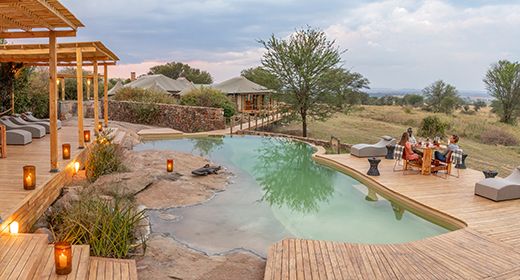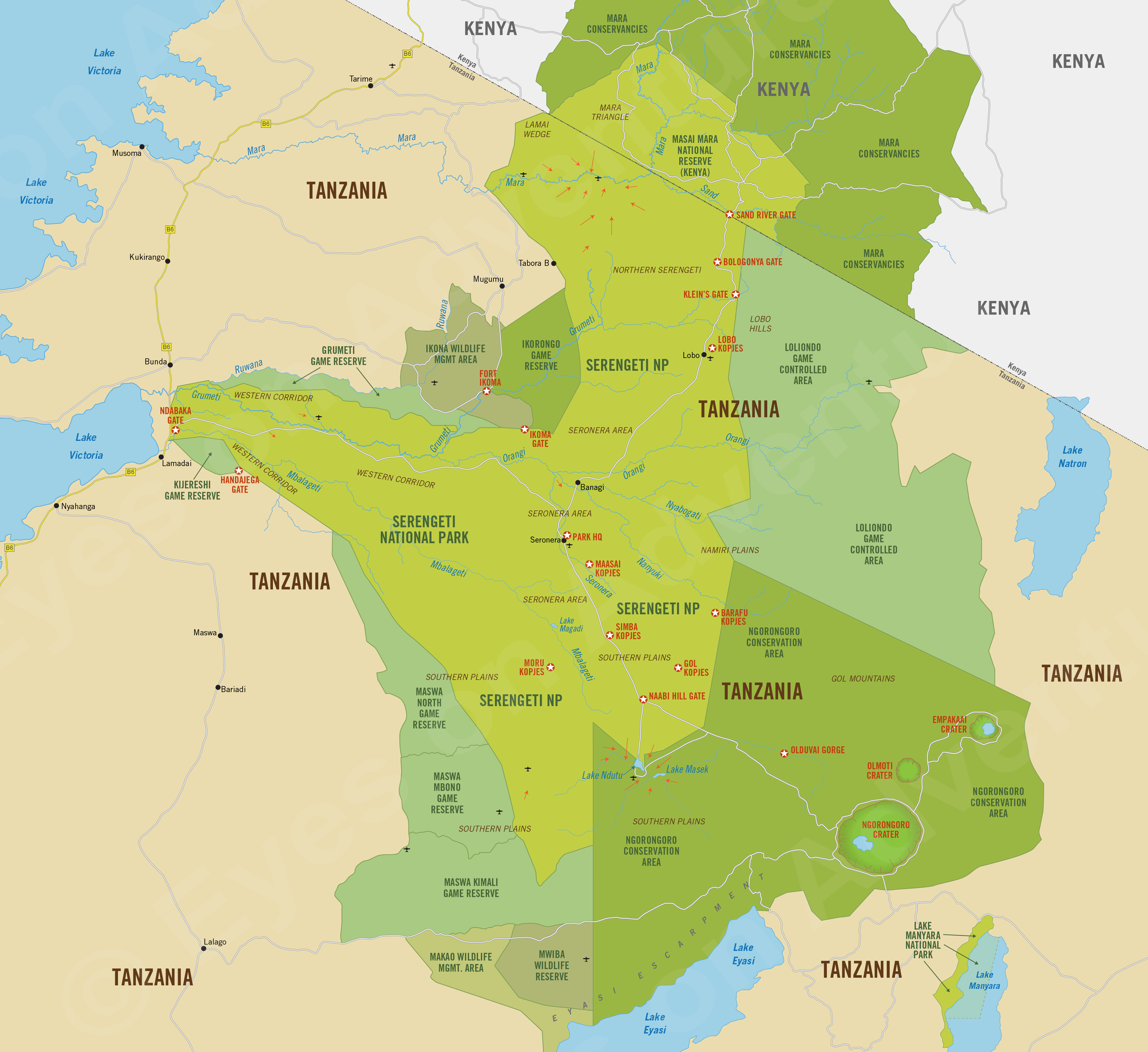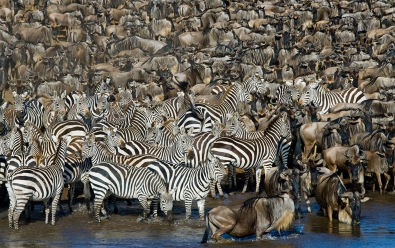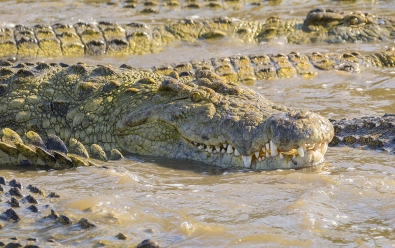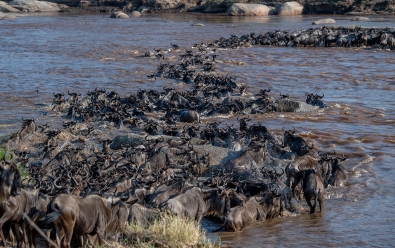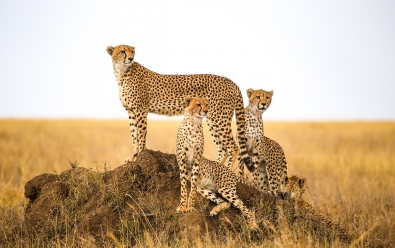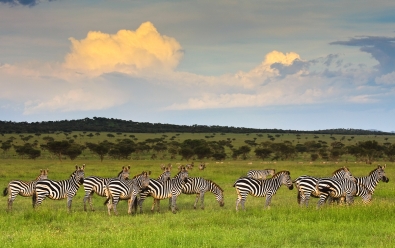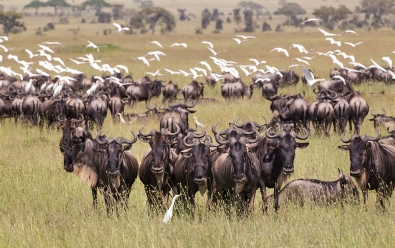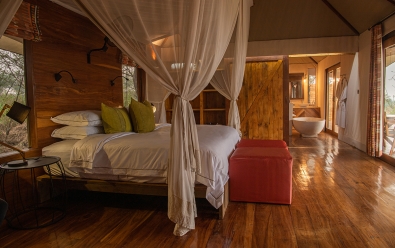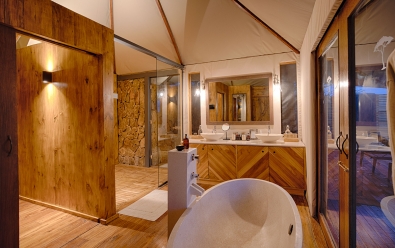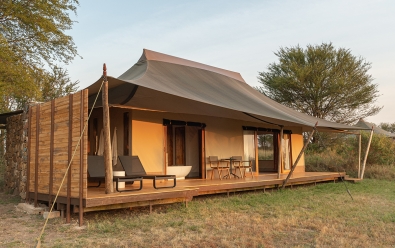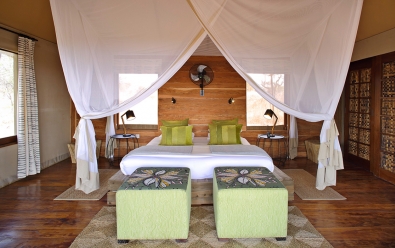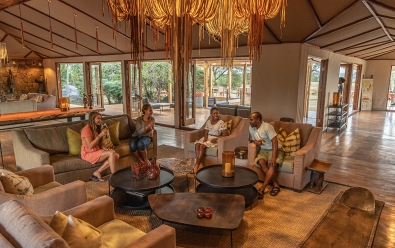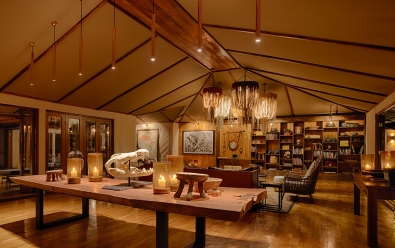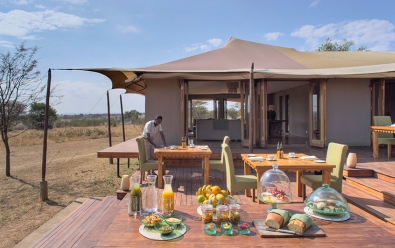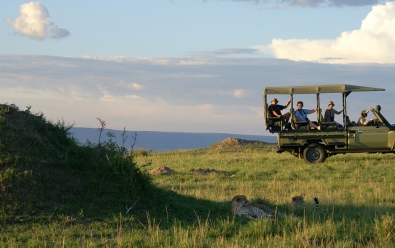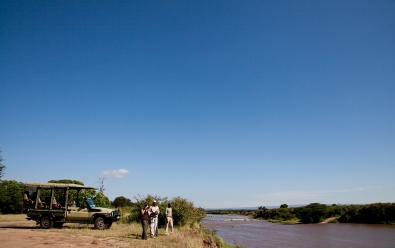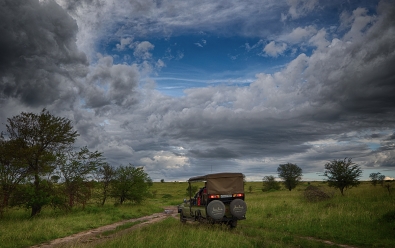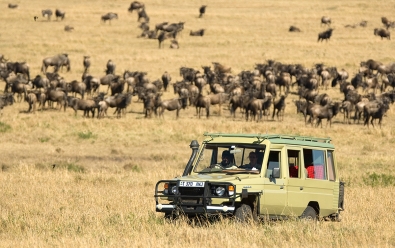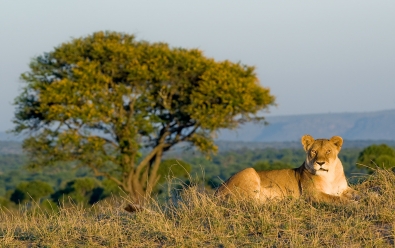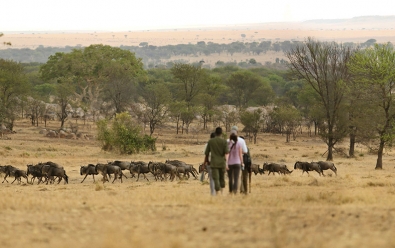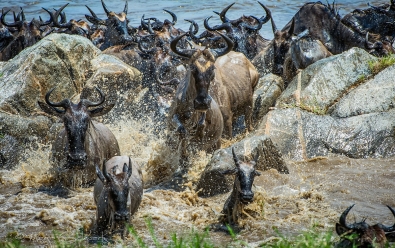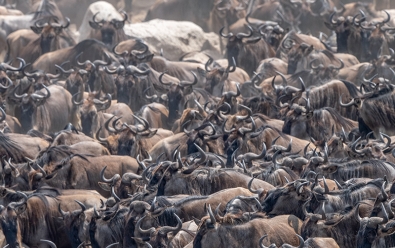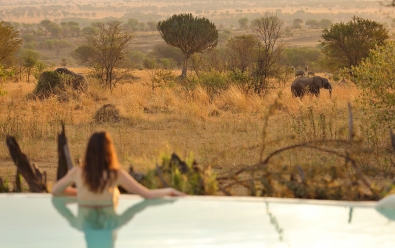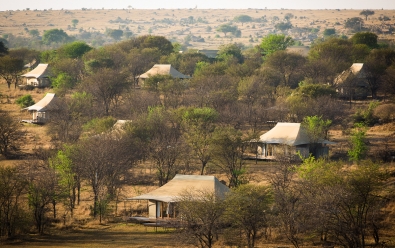Sayari Camp
Highlights
- Very good year-round wildlife viewing
- In the path of the Great Migration of two million herbivores
- Close to the Mara River for dramatic crossings during the migration
- Game drives, bush walks, culture, on-site microbrewery
Location
- Northern Sector / Mara River
- Serengeti National Park
- Northern Tanzania
Sayari Camp is optimally positioned only a few minutes' drive from the Mara River in a superb year-round wildlife area in the far Northern Serengeti, which is visited annually by the Great Migration.
The camp's location allows guests quick access to the Mara River, where dramatic crossings entailing a dangerous swim through waters with hungry crocodiles. The migrating wildebeests and zebras visit the area around Sayari annually between July and October before heading further north into Kenya and the Masai Mara.

One of Sayari's main area guest lounges.
Outside of the migration months, the area is home to plentiful wildlife, including lion, leopard, cheetah, spotted hyena, topi, zebra, giraffe, buffalo, hartebeest, Thomson's and Grant's gazelle, warthog, and more. Rhino are occasionally seen.
Activities at Sayari Camp include daytime game drives, guided bush walks (seasonally during the high season when the grass is short), picnics along the Mara River, birding, hot-air ballooning, cultural experiences with the local Kuria tribe, and spa treatments. Families with children are welcome and special activities for kids are included.
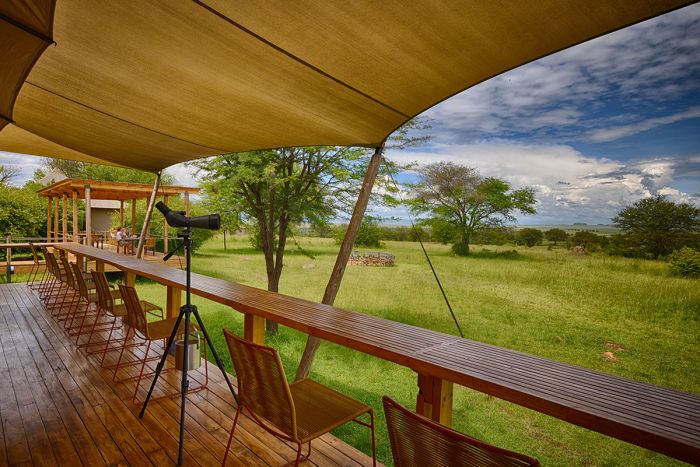
Main area deck and view at Sayari Camp.
Sayari Camp offers 15 luxurious, tented guest suites, one of which is a two-bedroom family tent and one of which is a 'honeymoon' tent with a private plunge pool. All of the tents have wrap-around outdoor verandas giving superb views over the Serengeti plains. The en-suite facilities are plumbed and include both indoor and outdoor showers and a chic bathtub.
The camp's guest suites are divided into two separate but adjacent 'wings', one with 6 tents and the other with 9 tents. Each wing has its own dining and lounge area in the middle of the camp. There is a large infinity swimming pool that is build into the natural rock formation in front of the camp. A spa offering a variety of wellness treatments and massages is another excellent way to relax between safari activities.
Unique to the camp, the solar-powered Sayari Microbrewery produces a selection of craft beers, purified water, sparkling water, and soft drinks. On-site drink production reduces the use of plastic and bottles.
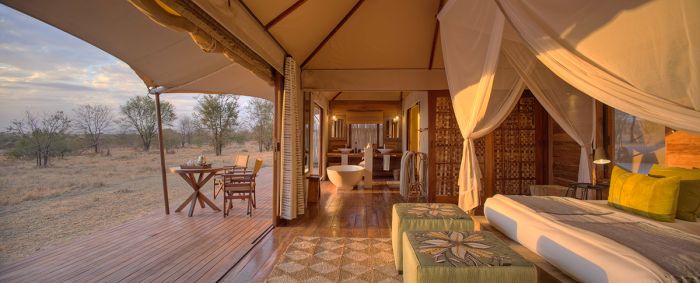
Guest suite and view at Sayari Camp.
About the Serengeti
The Greater Serengeti is part of an extensive ecosystem that includes Serengeti National Park, the Ngorongoro Conservation Area, and other reserves, wildlife management areas, and game controlled areas.
The Greater Masai Mara (directly to the north in Kenya) includes the Masai Mara National Reserve, as well as numerous private Mara conservancies. Together, the combined Greater Serengeti-Mara ecosystem, which combines the areas described above, covers roughly 15 000 square miles (39 000 sq kms).
The Serengeti-Mara is home to a very large number and diversity of wild animals and is also the location of the well-known "Great Migration" of over 2 million herbivores (read more below). This is arguably Africa's greatest overall wildlife destination.
Wildlife densities in the Greater Serengeti are some of the highest in Africa, with commonly seen herbivores including blue wildebeest, plains zebra, Thomson's gazelle, topi, Grant's gazelle, hartebeest, giraffe, elephant, buffalo, impala, waterbuck, bushbuck, warthog, and many others. Predators seen often include lion, leopard, spotted hyena, cheetah, serval, and jackal. Hippo and crocodile are found in large numbers in the larger rivers, including the Mara River and the Grumeti River.

Elephants seen from Sayari Camp in the Northern Serengeti.
About the Northern Serengeti
The hilly northern sector of Serengeti National Park stretches north from the central Seronera portion of the park all the way to the Mara River and the Kenya border. The northern sector is characterized by Acacia thickets and rolling grasslands and comprises about one-third of the park.
Besides the Mara River, which is the focal point of dramatic river crossings by wildebeests and zebras in from around late July into September, the northern sector also includes part of the Grumeti River and the well-known Lobo region, with its dramatic rock formations known as 'kopjes'.
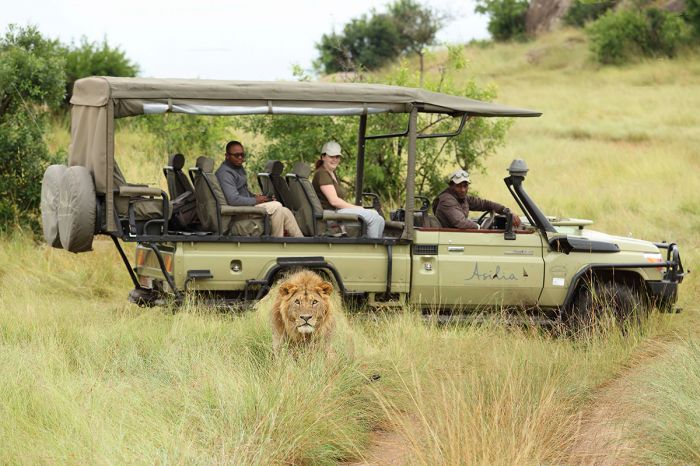
A male lion seen on game drive at Sayari Camp.
Most of the safari camps in the north are situated along or very near to the Mara River, which becomes the focal point of action when the migrating herds of wildebeest and zebra arrives sometime around early August. This area along the Mara River is known as 'Kogatende' and the proliferation of camps along the river is due to the incredible wildlife viewing opportunities here when the herds arrive. The drama unfolds when the herds congregate and eventually cross the Mara River en masse with plenty of huge crocodiles in wait. August is the peak month for river crossings, but Kogatende offers superb wildlife viewing from August thru October.
The Lobo area, which is located in the southern extent of the northern sector and along the eastern border of the national park, is excellent during late September and October, when the wildebeest and zebra migration passes through on its way back south from Kenya, heading towards the southern plains. Lobo Kopjes, a group of huge granite boulders is a favorite hangout for large prides of lions and also draws leopards, spotted hyenas, and even cheetahs.
Excluding the migration period, the overall wildlife viewing in the north is not as spectacular as the more "classic" and open areas further south in Seronera and the Southern Plains, but there is still good resident wildlife in the north. Most of the Serengeti's elephants are found in the north, and there are also good resident numbers of zebra, buffalo, warthog, and gazelle.

Spotted hyenas with a wildebeest kill near Sayari Camp in the Northern Serengeti.
The Great Migration
One of nature's greatest living spectacles is the Great Migration, a term given to describe the year-long, circular, clockwise march of over two million herbivores across the Serengeti and Masai Mara grasslands. The migration animals are made up entirely of two species: the blue wildebeest and the plains zebra (the majority of which are wildebeests).
The migrating herds follow their instincts to seek out fresh grazing and so the migration is ongoing, with the herds ever moving and taking a full year to complete a cycle across the Serengeti and Masai Mara. The animals move not as one herd, but as tens of thousands of animals in multiple herds of various sizes and spread out for many miles as they move.
The wildebeests and zebras take advantage of strongly seasonal conditions, spending the wet season (November through May) on the plains of Tanzania's Serengeti and the dry season in Kenya's Masai Mara. The wildebeests give birth between January and March on the short grass plains in the southern Serengeti.
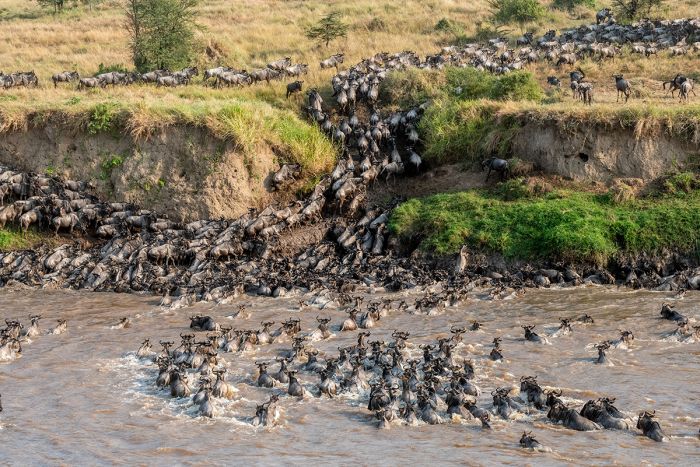
Wildebeests crossing the Mara River near Sayari Camp.
The timing of the migration is rarely ever the same year-to-year, as local conditions influence grass growth and as such, the location of the bulk of there animals cannot be known precisely. Rains and other unknown conditions seem to direct the timing of the migration, but generally, it is known within several weeks when the animals will be in a general location.
The animals spread out to cover a vast area, but the main bulk of the animals moves south into the northern Serengeti around late-October and continue moving south towards the Serengeti's southern plains, arriving there sometime in January to graze on the rich grass growing on the volcanic soils. It is here on these short-grass plains, between January and early March, when the wildebeests give birth to their young en masse, producing some 500 000 baby wildebeests.
The herds remain on the southern short-grass plains until late March, giving the young animals time to grow and become strong, before heading north and west again. Many of the animals move towards the Serengeti's Western Corridor and Grumeti Reserve and the rest straight north into Central and Northern Serengeti, where they remain during June and into July. The herds move back into Kenya starting in late July, with the bulk moving into the Masai Mara in August.
Although many visitors time their visit to the Serengeti to coincide with the Migration, any region within the Serengeti offers very good wildlife viewing outside of the months when the migration may be present. This is because it is only the wildebeests and zebras that migrate, while the rest of the animals, including the major predators like lion, leopard, spotted hyena, and cheetah, as well as all the other herbivores, including springbok, gazelles, elephant, topi, hartebeest, and many others, do not migrate.
A popular aspect of experiencing the Great Migration is observing a herd as it crosses the Mara River, which requires animals swimming through waters inhabited by large Nile crocodiles that wait for a chance to get their first substantial meal in many months.
The dramatic river crossings (which take place along the Mara River in both Kenya and Tanzania) are certainly a spectacle and not for the faint of heart, with many of the wildebeest and zebras taken by crocs or succumbing to drowning or trampling in the chaos. The best chances for seeing a Grumeti River crossing is in June, while Mara River crossings are best in July and August.
ROOMS INCLUDES & EXCLUDES CHILDREN FACILITIES ACTIVITIES
Accommodation
15 guest accommodations in total comprising:
- 14 canvas-tented suites, all of which can be set up with a king or twin beds. Three tents are available as a triple with a child under 16 years sharing. One of the tents is set at the far end of camp, and is called the 'honeymoon suite', as it has a second private bath (located outside the tent) shaped like a heart.
- 1 canvas-tented family suite consisting of two bedrooms, one with a king-size bed (convertible to twins) and the other with three single beds. The bedrooms each have their own en-suite facilities and are separated by a shirt, enclosed walkway.
The spacious suites have canvas walls and roofs supported by wooden beams and natural stone atop slightly-elevated mahogany wood platforms. A wrap-around outdoor veranda spans the front and one side of the suite.
Every tent includes plumbed en-suite facilities with a double-basin vanity, indoor shower, a second outdoor shower on the side deck, an egg-shaped bathtub with full views of the Serengeti plains, and a separate toilet. The second bedroom in the family suite has a single-basin vanity and indoor shower (no bathtub north outdoor shower).
The guest suites are grouped into two "wings", one with 9 suites and the other with 6 suites. Both sections of the camp have their own separate dining and lounge spaces (located adjacent to each other in the middle of the camp). The guest suites are accessed via footpaths on the ground leading to the main camp area.
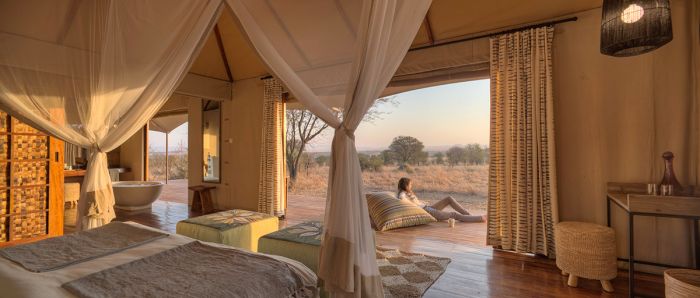
Guest suite interior and view at Sayari Camp.
The camp and guest tents are located a short distance south of the Mara River and in a perfect position to see river crossings during the migration months (mid-July thru October). The guest suites have excellent views out onto the plains surrounding the camp.
The safari-chic décor in the guest suites is inspired by the surrounding Serengeti landscape, with natural earthy hues and pastel colors. Each suite has an outdoor veranda with daybed loungers, a table, and chairs. The family tent feature a separate outdoor deck for each of the two bedrooms.
Other items and features in the guest tents include:
- Outdoor veranda with comfortable daybeds.
- Mosquito netting over the beds.
- Wall fan above the bed(s).
- Safe.
- Clothes wardrobe / closet.
- Bathrobes.
- 24-hour power (provided using a combination of solar and generator) for lighting and charging electronics.
- Hairdryer.
- Wi-Fi available in the guest suites and main camp area.
- Mobile phone signal available, but limited.
Sayari Camp can accommodate a maximum of 36 guests in total: 2 persons in each of the 14 standard tents, 5 persons in the family tent, and 3 additional beds for a child sharing in a triple standard tent.
Includes & Excludes
Includes:
- All meals and house drinks, including wines, local brand spirits and beers, teas, and coffees.
- Safari experiences (twice-daily scheduled game drives, seasonal bush walks, and birding) accompanied by an experienced guide.
- Sundowner drinks and snacks.
- Laundry services are provided on a daily basis (weather permitting, items will be returned on the same day). Laundry is dried by the sun and on most days any laundry placed out in the morning will be returned by the evening.
- Wi-Fi access (in the guest suites and main guest area).
- Kogatende Airstrip transfers.
- Tourism Levy & VAT.
Excludes:
- Champagne, cognacs, fine wines, premium brand spirits, and cigars.
- Hot-air ballooning.
- Spa treatments.
- Cultural visit to a local community outside the national park.
- Purchases from the Gift Shop.
- Any applicable wildlife fee, park fee, reserve fee, concession fee, other land-use fee.
Single Supplement
A single supplement may apply for any room booked by a single traveler; please ask us for pricing.
Children
Children aged 5 years and older are accommodated at Sayari Camp:
- 1 family tent and 3 standard tents available as a triple.
- Ask us about reduced rates for children sharing with adults or children 12-17 in their own tent.
- The minimum age for children on bush walks is 12 years and at the discretion of the guide.
- Children's menu available.
- Children under 5 years are allowed only if the camp is booked exclusively.
Game drives with children:
- During high and peak seasons, families (less than 5 persons) with children aged 0-12 years must pre-book a private vehicle.
- During low and peak seasons, families (less than 5 persons) with children aged 0-12 years will receive a private vehicle FOC subject to availability. Vehicle must be pre-booked.
- Year-round, families with children aged 0-12 years will receive a private vehicle FOC for every 5 persons in the family. This is subject to vehicle availability and must be booked in advance.
Facilities
Sayari Camp is informally divided into two wings, with the guest suites on either side of the camp's main guest areas. One of the wings has 6 guest suites and the other has 9 suites.
Each wing has a dedicated dining and lounge area, which are situated adjacent to one another in the middle of the camp. Either 'wing' of the camp can be booked in its entirety by groups looking for an exclusive experience.
The camp's main areas include two separate dining spaces and two separate lounge and bar spaces constructed using canvas walls and roofing, natural stone, wooden support beams, and polished hardwood flooring. Glass sliding doors and roll-down canvas flaps open onto outdoor viewing decks that give views onto the Serengeti plains.
A lovely infinity swimming pool is built into the natural rock in front of the camp and the large pool deck with loungers is a great place to enjoy the views between safari activities.
Unique to the camp, the solar-powered Sayari Microbrewery produces a selection of craft beers, purified and sparkling waters, and soft drinks. On-site water production reduces the use of plastic and bottles.
Main guest area facilities include:
- Two separate dining and lounge areas, each supporting one of the camp's two 'wings'.
- Infinity swimming pool with sundeck.
- Microbrewery.
- Spa.
- Two separate campfire areas.
- Gift Shop.
- Complimentary Wi-Fi access.
- Mineral water is provided in the main camp areas and in the guest tents.
- The camp is powered by a combination of solar and generator.
Activities
Activities included in the rate:
- Morning and afternoon/evening game drives in semi-open 4x4 vehicles.
- Sundowners.
- Mara River picnics and hippo / crocodile watching.
- Guided bush walks. This activity is seasonal and generally not available in the rainy season when the grass becomes too high. Children must generally be 12 years of age (or given clearance at the discretion of the guide).
- Birding.
- Child-friendly activities.
- All game drive vehicles fitted with inverters for battery charging on game drives.
Optional activities at additional cost:
- Private activities are on offer (subject to vehicle availability, which needs to be booked in advance).
- Use of the customized Asilia photographic game drive vehicle. The vehicle is based at Sayari, but also bookable from Olakira and Ubunto camps. Maximum three photographers. Best to reserve in advance.
- Hot-air ballooning (may be booked in advance).
- Guided visit to a local Kuria tribe homestead (full-day excursion). Alternately, an evening visit to the camp by Kuria tribe members can be arranged.
- Spa treatments.
Example of a typical day:
- Early morning wake-up call. Morning wake-up and activity times vary according to the seasons, activities on offer, and wildlife sightings.
- Light breakfast before departing on the morning activity or food packed for an earlier departure.
- Return to the camp for a meal and rest period (full-day outings mean lunch is packed).
- Meet for afternoon tea and snacks (savory and sweet choices) before departing on the activity.
- Return to camp - freshen up or meet for drinks, followed by dinner.
- Enjoy a nightcap and/or discussion at the bar or around the campfire before retiring.
Great Good Fair Poor
- Jan
- Feb
- Mar
- Apr
- May
- Jun
- Jul
- Aug
- Sep
- Oct
- Nov
- Dec
General Tips
It is advised to avoid the Serengeti over March and April, when heavy rains typically occur. June to mid-October is excellent for general game viewing. The large herds of animals in the Great Migration usually cross into the Serengeti from Kenya's Masai Mara sometime around early October and move north back into Kenya around mid- to late-July.
Besides the Great Migration, the other big factor that impacts a stay in the Serengeti is rains. The region experiences most of its rain between November and May, but there are two somewhat distinct rain seasons, the 'short' rains and the 'long' rains (read more below).
Sayari Camp is closed 01-April thru 31-May (minimum 2 night stay).
Rains
Short Rains
The short rains occur for about one month sometime during November and December (the exact time varied somewhat year to year). This period is called the 'short' rains because the duration of an individual rain event is short and it is rare to have an all-day rain event. Most rain falls as an afternoon shower, while mornings are typically overcast or clear.
Long Rains
The long rains occur between March and May, with April being the wettest month of the year. During this tome, rain should be expected almost every day and the showers can last for hours at a time, although all-day rain is not typical. The roads in the Serengeti become muddy and very difficult in places, which can hamper game drives. Cloudy skies are typical and temperatures can be chilly at times.
The period between the short and long rains (January and February) also receives rain, but many days are clear and the amount and duration of the rain events is unpredictable, with some afternoon showers and the odd long and heavy rainfall event.
Temperatures
The temperatures in the Greater Serengeti do not experience wide fluctuation throughout the year, as the region lies between one and three degrees south of the equator. In general, daytime temperatures are comfortably warm and overnights and early mornings are chilly. Bring a fleece and rain jacket regardless of the timing of your visit.
Dry Season
The dry season (June to October) is sunny and warm most days and rarely hot. Rare rain showers can occur but are unlikely. From June thru August, the afternoon temperature averages 76-78°F (24-25°C), but some days can be warmer. Evenings and early mornings temperatures are often chilly, averaging 53-55°F (12-13°C).
September and October days are very pleasant, with temperatures averaging 80-83°F (28-30°C), with cool mornings persisting, averaging 53-56°F (11-13°C).
Rainy Season
The rain season is November through May (read more above) and the temperatures are fairly static throughout the season. Daytime temperatures average 79-83°F (26-28°C) and nighttime and early morning temperatures are chilly, but slightly warmer than the dry season, averaging 54-57°F (12-14°C)
The Great Migration
The annual movement of wildebeest and zebras across the Serengeti-Mara ecosystem is one of the greatest spectacles in the natural world. These large herds move in a circular track across southern Kenya and northern Tanzania, taking a full year to complete their cycle. The migration moves across both the Greater Masai Mara (in Kenya) and the Greater Serengeti (in Tanzania) in a fairly consistent pattern and timeframe. The animals move to take advantage of fresh grasses on which to graze.
The migrating herds of roughly 1.5 million blue wildebeests and several hundred thousand plains zebras spend about nine months of the year moving through Tanzania's Greater Serengeti and the other three months in Kenya's Greater Masai Mara. The migrating herds are in Tanzania's Greater Serengeti from sometime in October until around late-July (note that the timing is never precise and varies somewhat year to year). Note that the Serengeti is vast, and it is important to note where in the region the herds are located during this nine-month timeframe.
The animals spread out to cover a vast area, but the main bulk of the animals moves south into the northern Serengeti around late-October and continue moving south towards the Serengeti's southern plains, arriving there sometime in January to graze on the rich grass growing on the volcanic soils. It is here on these short-grass plains, between January and early March, when the wildebeests give birth to their young en masse, producing some 500 000 baby wildebeests.
The herds remain on the southern short-grass plains until late March, giving the young animals time to grow and become strong, before heading north and west again. Many of the animals move towards the Serengeti's Western Corridor and Grumeti Reserve and the rest straight north into Central and Northern Serengeti, where they remain during June and into July. The herds move back into Kenya starting in late July, with the bulk moving into the Masai Mara in August.
The migration is rarely ever the same in terms of precise timing and direction, as local rains and other conditions influence grass growth. The wildebeest may, therefore, move off the open plains earlier in some years and remain in the northern Serengeti for longer in others. Nonetheless, the best months for seeing the migration in the Southern Serengeti are in February and March, when the herds are adding new babies, in the Central Serengeti during May and June, when the herds are the most concentrated, and in the Western Corridor, Grumeti, and far Northern Serengeti from June thru August.
Many visitors hope to witness dramatic river crossings, when hungry crocodiles attack the herds as they swim across the dangerous rivers of the Northern Serengeti. Like the migration in general, the precise timing of the river crossings is never known from year to year, but crossings on the Grumeti River are usually best in June, while Mara River crossings are best in July and August.




